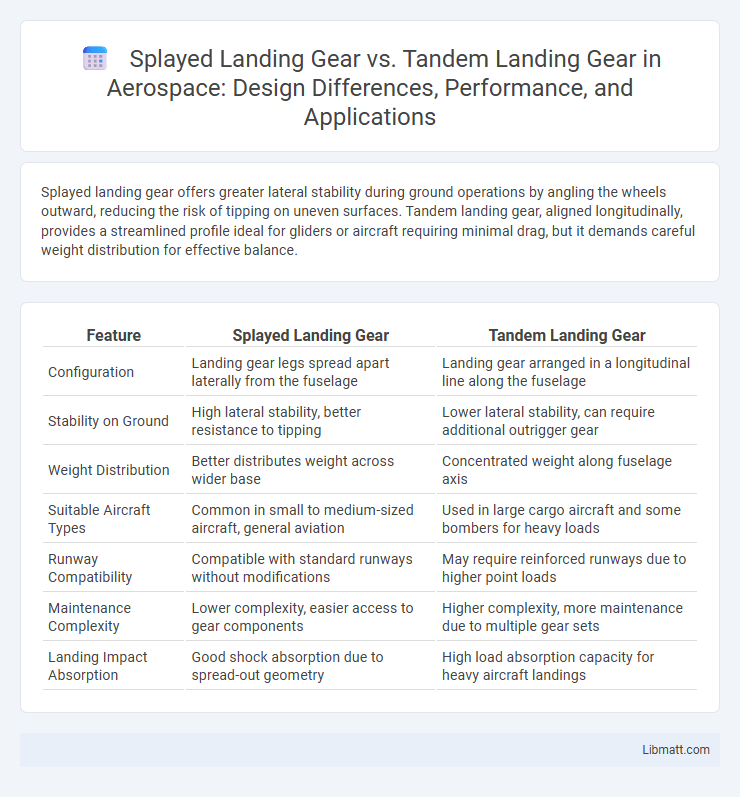Splayed landing gear offers greater lateral stability during ground operations by angling the wheels outward, reducing the risk of tipping on uneven surfaces. Tandem landing gear, aligned longitudinally, provides a streamlined profile ideal for gliders or aircraft requiring minimal drag, but it demands careful weight distribution for effective balance.
Table of Comparison
| Feature | Splayed Landing Gear | Tandem Landing Gear |
|---|---|---|
| Configuration | Landing gear legs spread apart laterally from the fuselage | Landing gear arranged in a longitudinal line along the fuselage |
| Stability on Ground | High lateral stability, better resistance to tipping | Lower lateral stability, can require additional outrigger gear |
| Weight Distribution | Better distributes weight across wider base | Concentrated weight along fuselage axis |
| Suitable Aircraft Types | Common in small to medium-sized aircraft, general aviation | Used in large cargo aircraft and some bombers for heavy loads |
| Runway Compatibility | Compatible with standard runways without modifications | May require reinforced runways due to higher point loads |
| Maintenance Complexity | Lower complexity, easier access to gear components | Higher complexity, more maintenance due to multiple gear sets |
| Landing Impact Absorption | Good shock absorption due to spread-out geometry | High load absorption capacity for heavy aircraft landings |
Introduction to Aircraft Landing Gear Configurations
Splayed landing gear features outward-angled wheels providing greater lateral stability during ground operations, commonly found on bush planes and taildraggers. Tandem landing gear arranges wheels sequentially along the aircraft's longitudinal axis, maximizing aerodynamic efficiency and facilitating operations on rough fields, typical in gliders and some military transports. Each configuration optimizes ground handling characteristics tailored to specific aircraft roles and operational environments.
What is Splayed Landing Gear?
Splayed landing gear features wheels that are angled outward from the aircraft's fuselage, providing a wider base for enhanced lateral stability during ground operations. This design reduces the risk of tipping and improves maneuverability on uneven terrain compared to tandem landing gear, which aligns wheels in a straight line along the aircraft's centerline. You can expect splayed landing gear to offer superior balance and support, especially for smaller or bush aircraft operating on rough airstrips.
What is Tandem Landing Gear?
Tandem landing gear consists of two main wheels aligned along the longitudinal axis of the aircraft, providing stability primarily during takeoff and landing on rough or unprepared surfaces. Unlike splayed landing gear, which has wheels spread apart to enhance lateral stability, tandem gear minimizes drag and is often used on aircraft designed for carrier operations or specialized terrain. Understanding the design differences helps optimize Your aircraft's performance and ground handling characteristics.
Key Design Differences: Splayed vs Tandem
Splayed landing gear features wheels positioned outward from the fuselage, enhancing lateral stability and ground clearance for aircraft during taxiing and landing. Tandem landing gear arranges wheels linearly along the aircraft's longitudinal axis, minimizing drag and weight but requiring additional support for lateral balance. The splayed design excels in rough terrain handling, while the tandem configuration favors aerodynamic efficiency and runway performance.
Advantages of Splayed Landing Gear
Splayed landing gear offers enhanced lateral stability during ground operations due to its wider stance, reducing the risk of tipping and improving safety on uneven surfaces. This configuration provides better shock absorption and load distribution during landings, which extends the airframe's lifespan. Maintenance is simplified with splayed gear because its components are more accessible compared to the closely aligned tandem setup.
Advantages of Tandem Landing Gear
Tandem landing gear offers superior ground clearance and enhanced stability on rough or uneven terrain, making it ideal for specialized aircraft operations. This design reduces the risk of propeller or fuselage damage during takeoff and landing by distributing weight along the centerline. Your aircraft benefits from improved load distribution and simplified structural design, contributing to overall durability and performance.
Operational Considerations and Performance
Splayed landing gear offers enhanced stability during ground operations, especially on uneven or soft surfaces, by distributing weight more broadly and reducing the risk of tipping. Tandem landing gear, often found on gliders and some military aircraft, provides better performance in narrow runway environments due to its streamlined alignment, though it may require additional lateral support to maintain balance. Your choice between these configurations should consider the typical operating conditions, ground handling requirements, and the aircraft's overall mission profile.
Safety and Stability Comparison
Splayed landing gear offers enhanced lateral stability due to its wider stance, reducing the risk of ground loops during taxiing and landing, which significantly improves safety on uneven or soft terrains. Tandem landing gear, aligned along the aircraft's longitudinal axis, provides superior directional control on rough strips but can be more susceptible to tipping on uneven surfaces. Overall, splayed gear is favored for improved static stability, while tandem gear requires careful handling to maintain balance and avoid ground incidents.
Typical Applications and Notable Aircraft
Splayed landing gear is commonly used in bush planes and STOL (Short Takeoff and Landing) aircraft such as the De Havilland Canada DHC-2 Beaver, providing enhanced stability on uneven terrain. Tandem landing gear, characterized by two main sets of wheels aligned longitudinally, is typically found in gliders and long-range bombers like the Boeing B-52 Stratofortress, optimizing aerodynamic efficiency and weight distribution. The choice between these landing gear types depends heavily on the aircraft's operational requirements and typical landing environments.
Future Trends in Landing Gear Design
Future trends in landing gear design emphasize enhanced performance and weight reduction, with splayed landing gear offering improved stability during taxiing and ground handling, while tandem landing gear provides better load distribution for heavy aircraft. Innovations in composite materials and active shock absorption systems aim to optimize both configurations for efficiency and durability. Your choice between splayed and tandem designs will increasingly depend on aircraft type and mission requirements as technology advances.
Splayed landing gear vs Tandem landing gear Infographic

 libmatt.com
libmatt.com